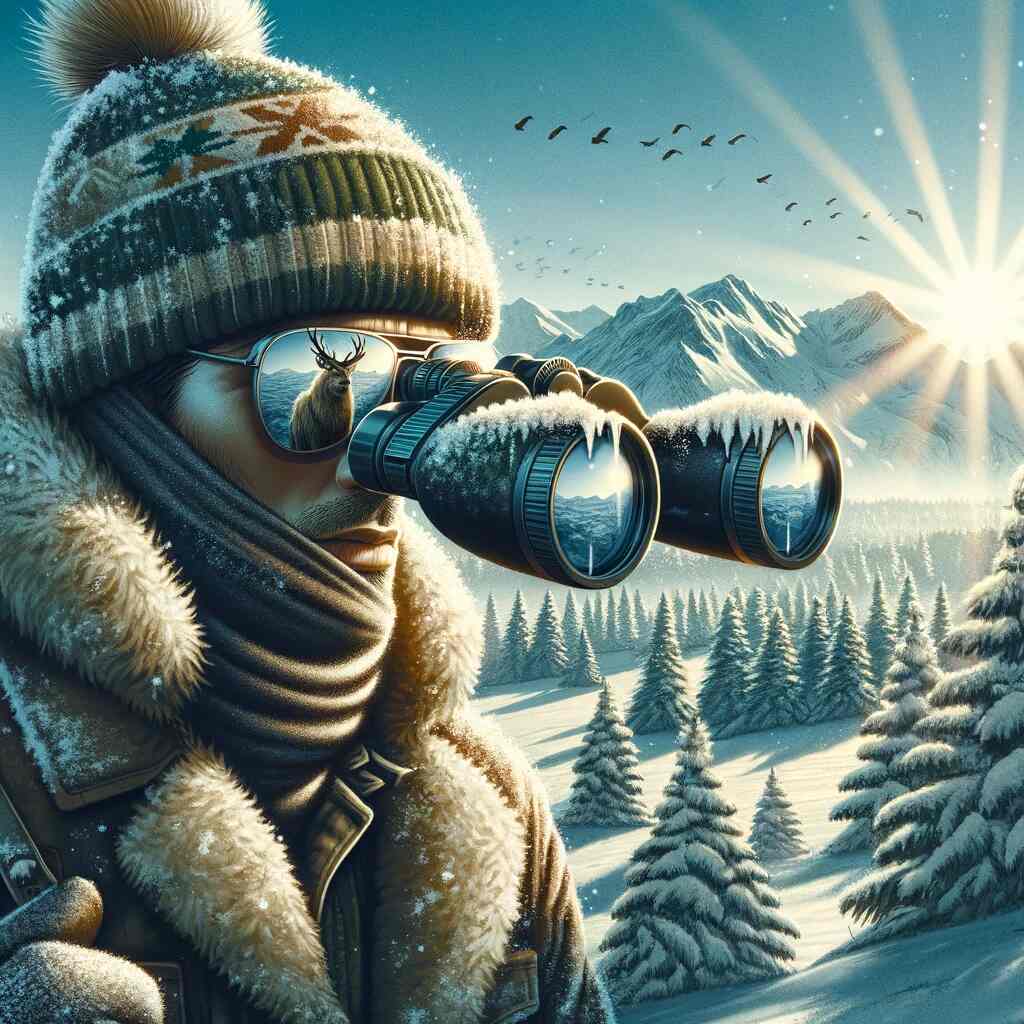Winter hunting can be an exhilarating experience. The crisp air, serene landscapes, and the thrill of the chase make it a favorite pastime for many outdoor enthusiasts. However, hunting in snowy conditions comes with its own set of challenges, and one of the most common and bothersome issues is snow glare. Snow glare can not only hinder your ability to spot game but also cause discomfort and eye strain.
In this comprehensive guide, we will explore various strategies and techniques to help you deal with snow glare effectively and maximize your success during winter hunts.
Understanding Snow Glare
Before delving into the methods to combat snow glare, it’s crucial to understand what it is and why it occurs. Snow glare is the intense, blinding reflection of sunlight off snow-covered surfaces. When sunlight hits the snow, it bounces off the tiny ice crystals, creating a dazzling and potentially blinding effect. This glare can make it difficult to see clearly and can be particularly problematic when hunting, as it can obscure your vision and make it challenging to spot game.
Several factors can contribute to the severity of snow glare, including:
- Snow Conditions: The type and condition of the snow can significantly affect glare. Fresh, untouched snow tends to reflect more light than packed or icy snow, intensifying the glare.
- Angle of the Sun: The angle at which the sun’s rays hit the snow can vary throughout the day. When the sun is low on the horizon, such as during sunrise or sunset, the glare can be especially intense.
- Terrain: The landscape you are hunting in can also impact snow glare. Open, flat areas with a lot of snow cover tend to produce more glare than wooded or hilly terrain.
- Eyewear: The type of eyewear you use can either help or exacerbate snow glare. Proper eyewear is essential for mitigating glare effectively.
Now that we have a better understanding of snow glare, let’s explore various strategies and techniques to deal with it while hunting.
Choose the Right Eyewear
One of the most effective ways to combat snow glare while hunting is to invest in high-quality eyewear specifically designed for outdoor activities in snowy conditions. Here are some considerations when choosing the right eyewear:
1. Polarized Sunglasses:
Polarized sunglasses are designed to reduce glare caused by reflected sunlight. They contain a special filter that blocks horizontal light waves, which are responsible for glare. By wearing polarized sunglasses, you can significantly reduce the intensity of snow glare, making it easier to spot game.
2. UV Protection:
Ensure that your eyewear provides 100% UV protection. Not only will this protect your eyes from harmful UV rays, but it will also reduce glare and improve visibility in bright conditions.
3. Lens Color:
The color of the lenses can impact your vision in different ways. Yellow or amber lenses can enhance contrast and improve visibility in low light conditions, such as overcast days or during dawn and dusk. Brown or copper lenses are also effective at reducing glare and enhancing contrast in snowy environments.
4. Anti-Reflective Coating:
Consider eyewear with anti-reflective (AR) coatings on the lenses. AR coatings reduce reflections on the front and back surfaces of the lenses, further minimizing glare.
5. Wraparound Design:
Opt for sunglasses with a wraparound design. This style provides additional protection from peripheral glare by minimizing the entry of light from the sides.
6. Interchangeable Lenses:
Some eyewear models come with interchangeable lenses, allowing you to adapt to changing light conditions. This versatility can be particularly useful during a day of hunting in varying weather.
7. Fit and Comfort:
Ensure that your eyewear fits comfortably and securely. Ill-fitting eyewear can cause discomfort and may not provide adequate protection from glare.
Investing in high-quality eyewear may seem like an expense, but it can greatly enhance your hunting experience by reducing snow glare and protecting your eyes.
Adjust Your Clothing and Gear
Beyond eyewear, you can make adjustments to your clothing and gear to minimize the effects of snow glare. Here are some considerations:
1. Choose Appropriate Camouflage:
Opt for winter camouflage patterns that blend in with snowy environments. This will help you remain inconspicuous and avoid detection by game animals. White or snow-patterned clothing can also help reduce the reflection of sunlight.
2. Face Masks and Balaclavas:
Wearing a face mask or balaclava can shield your face from direct sunlight and glare. Look for options that are breathable and moisture-wicking to keep you comfortable during long hours in the field.
3. Use Lens Filters:
Lens filters, such as anti-glare lens filters, can be attached to your optics, such as binoculars or scopes. These filters help reduce glare and improve visibility, especially when scanning the terrain for game.
4. Opt for Matte Finishes:
Choose gear with matte or non-reflective finishes. Shiny or glossy surfaces can reflect sunlight and contribute to glare.
5. Snow Goggles:
In extreme glare conditions, consider wearing snow goggles. These provide maximum protection from glare and can be worn over prescription eyewear if necessary.
Time Your Hunts Strategically
The timing of your hunting trips can significantly affect your exposure to snow glare. Consider the following strategies:
1. Hunt During Low-Light Hours:
Plan your hunts during periods of low light when the sun is less intense. Dawn and dusk are ideal times, as the sun is lower on the horizon, reducing glare. Additionally, these hours are when many animals are most active.
2. Use Shadows to Your Advantage:
Position yourself in areas where natural shadows provide relief from direct sunlight and glare. Trees, rocks, and terrain features can cast shadows that offer concealment and reduce glare.
3. Monitor Weather Forecasts:
Keep an eye on weather forecasts and choose days with overcast skies when sunlight is diffused. Overcast conditions can help minimize glare and provide better hunting opportunities.
Utilize Terrain and Topography
The terrain and topography of your hunting area can either exacerbate or mitigate snow glare. Here’s how to use them to your advantage:
1. Seek Natural Cover:
When possible, position yourself near natural cover such as trees, shrubs, or rocky outcrops. These features can provide shade and reduce the impact of snow glare.
2. Elevate Your Position:
If you’re hunting in hilly or mountainous terrain, consider elevating your position. Being on higher ground can give you a vantage point where you’re less affected by glare from below.
3. Use the Landscape:
Blend into the landscape by positioning yourself against backgrounds that break up your silhouette. Snow-covered terrain can be deceivingly bright, so having a background that contrasts with your outline can help you remain concealed.
Adjust Your Hunting Techniques
In addition to gear and environmental considerations, you can also adjust your hunting techniques to deal with snow glare effectively:
1. Move Slowly and Quietly:
In snowy conditions, sound travels differently, and animals can hear you from a greater distance. Move slowly and quietly to avoid alerting game to your presence. Snowshoes or gaiters can help reduce noise when walking in snow.
2. Use Binoculars and Scopes:
Instead of relying solely on your naked eye, use binoculars or scopes to scan for game from a distance. These optical tools can help you identify targets without exposing yourself to glare.
3. Be Patient:
Snowy conditions can make it more challenging to spot game, so patience is key. Find a concealed spot, settle in, and wait for animals to move into your field of view. Avoid unnecessary movements that can catch the sun’s reflection.
Practice Sun Safety
While dealing with snow glare, it’s crucial not to forget about sun safety. The intense sunlight reflecting off the snow can increase your risk of sunburn and eye damage. Here’s how to stay safe:
1. Wear Sunscreen:
Apply sunscreen to all exposed skin, including your face, neck, and ears. Use a high-SPF sunscreen to protect against harmful UV rays.
2. Use Lip Balm with SPF:
Don’t forget to protect your lips from sunburn by using a lip balm with SPF.
3. Cover Your Head:
Wear a wide-brimmed hat or a beanie that covers your ears to protect your face and head from direct sunlight.
4. Stay Hydrated:
Drinking water is essential, even in cold weather. Snow reflects sunlight, which can lead to dehydration, so be sure to stay hydrated throughout your hunt.
5. Wear Sunglasses or Goggles:
In addition to protecting your eyes from glare, sunglasses or goggles with UV protection can shield your eyes from harmful UV rays.
Conclusion
Hunting in snowy conditions can be a rewarding experience, but it also presents challenges, particularly in dealing with snow glare. By choosing the right eyewear, adjusting your clothing and gear, timing your hunts strategically, utilizing terrain and topography, and adapting your hunting techniques, you can effectively combat snow glare and increase your chances of a successful hunt.
Remember that safety should always be a top priority. Protect your eyes from both glare and harmful UV rays, and take precautions to prevent sunburn and dehydration. With the right preparation and techniques, you can fully enjoy the beauty of winter hunting while minimizing the impact of snow glare. Happy hunting!










